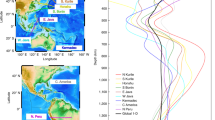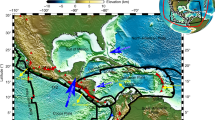Abstract
—An attempt is made to explore the geodynamical significance of seismic anisotropy in the deep mantle on the basis of mineral physics. The mineral physics observations used include the effects of deformation mechanisms on lattice and shape preferred orientation, the effects of pressure on elastic anisotropy and the nature of lattice preferred orientation in deep mantle minerals in dislocation creep regime. Many of these issues are still poorly constrained, but a review of recent results shows that it is possible to interpret deep mantle seismic anisotropy in a unified fashion, based on the solid state processes without invoking partial melting. The key notions are (i) the likely regional variation in the magnitude of anisotropy as deformation mechanisms change from dislocation to diffusion creep (or superplasticity), associated with a change in the stress level and/or grain-size in the convecting mantle with a high Rayleigh number, and (ii) the change in elastic anisotropy with pressure in major mantle minerals, particularly in (Mg, Fe)O. The results provide the following constraints on the style of mantle convection (i) the SH > SV anisotropy in the bottom transition zone and the SV > SH anisotropy in the top lower mantle can be attributed to anisotropy structures (lattice preferred orientation and/or laminated structures) caused by the horizontal flow in this depth range, suggesting the presence of a mid-mantle boundary layer due to (partially) layered convection, (ii) the observed no significant seismic anisotropy in the deep mantle near subduction zones implies that deformation associated with subducting slabs is due mostly to diffusion creep (or superplasticity) and therefore slabs are weak in the deep mantle and hence easily deformed when encountered with resistance forces, and (iii) the SH > SV anisotropy in the cold thick portions of the D" layer is likely to be due to horizontally aligned shape preferred orientation in perovskite plus magnesiowüstite aggregates formed by strong horizontal shear motion in the recent past.
Similar content being viewed by others
Author information
Authors and Affiliations
Additional information
Received November 5, 1996, revised April 18, 1997, accepted May 22, 1997
Rights and permissions
About this article
Cite this article
Karato, S. Seismic Anisotropy in the Deep Mantle, Boundary Layers and the Geometry of Mantle Convection. Pure appl. geophys. 151, 565–587 (1998). https://doi.org/10.1007/s000240050130
Issue Date:
DOI: https://doi.org/10.1007/s000240050130




